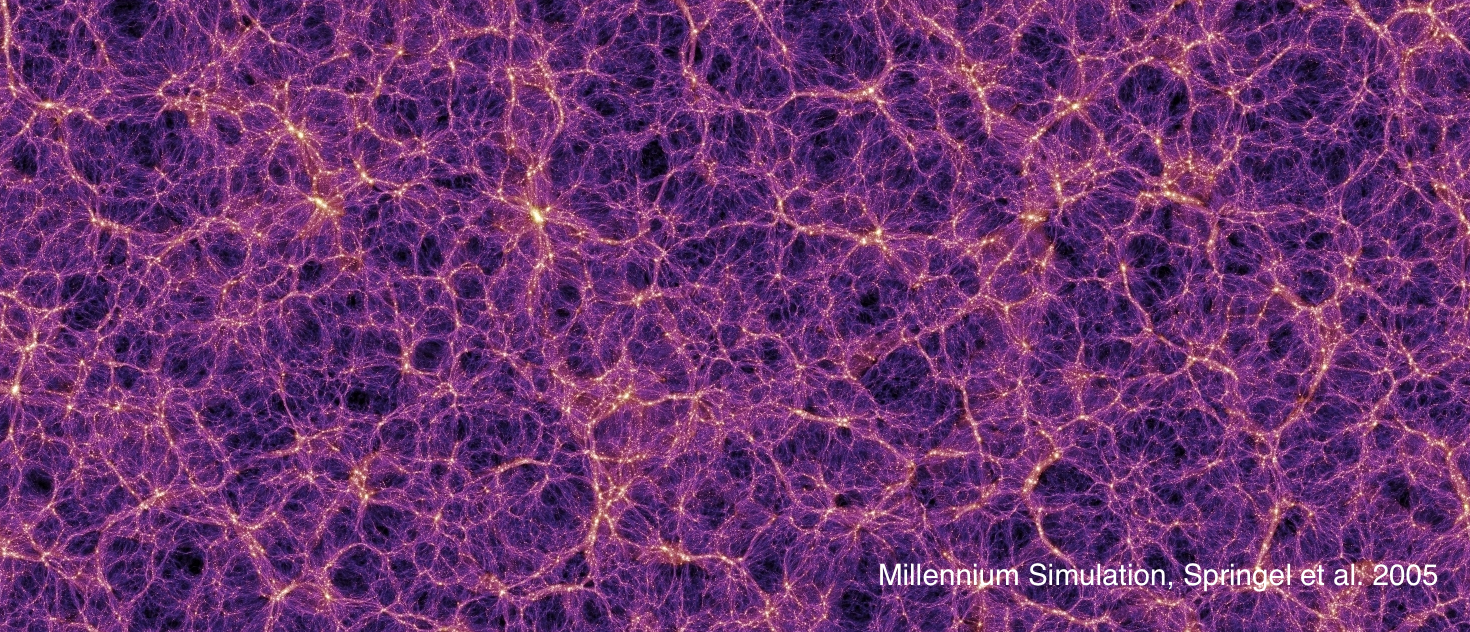Welcome to the L-Galaxies webpage! L-Galaxies is a cosmological-scale semi-analytic simulation of galaxy evolution, which runs on the dark matter
halo "merger trees" generated by N-body simulations of hierarchical structure formation.
Thanks to its semi-analytic nature, L-Galaxies is able to model the evolution of many millions of galaxies from very early times to the present
day much more efficently than hydrodynamical simulations of comparable size. This makes L-Galaxies ideal for testing models of astrophysical
processes, as well as studying statistically-significant samples of galaxies and the supermassive black holes they host. For more information
on the physics models included in L-Galaxies, see here.
L-Galaxies has been continually developed for over a quarter of a century and is based on the seminal works of White 1989; White & Frenk 1991;
Kauffmann et al. 1993,1999; Springel et al. 2001,2005; leading to the latest versions by Henriques et al. 2020; Ayromlou et al. 2021; Izquierdo-Villabla et al. 2022; Yates et al. 2024.
The completion of the Millennium and Millennium-II simulations enabled implementation of L-Galaxies onto dark matter simulations of high enough resolution and large enough size to probe
galaxies throughout cosmologically relevant volumes. Updates to the baryonic physics have resulted in a series of publicly
released catalogues that have been widely used by the community.
The code and sample output catalogues from recent L-Galaxies versions can be downloaded here.
Output data can also be obtained from the
Millennium Database via the SQL interface or
TOPCAT.
For access to the full database (including L-Galaxies 2020 tables), see
here.
L-Galaxies vs. observations

Left: A mock HST image of a lightcone from the L-Galaxies simulation. Right: The real Hubble Ultra Deep Field (HUDF).

A slice through the Millennium simulation. L-Galaxies is run on dark matter halo merger trees generated from N-body simulations such as Millennium.
Below are links to download the outputs, code, and documentation relating to recent versions of L-Galaxies.

Yates et al. (2024)
builds on the models of Henriques et al. (2020) and Yates et al. (2021a) by including (a) binary stellar
evolution (via the binary_c BSE code) and
(b) dust production and destruction into L-Galaxies. In addition to binary effects,
the inclusion of binary_c allows all 118 chemical elements (487 isotopes) from 16 distinct enrichment channels to be tracked.
The combination with radially-resolved discs in galaxies also allows the spatial distribution of dust in molecular and diffuse gas to be modelled.

The Spinoso et al. (2023) version is based on the Henriques et al. (2015) release
with the modifications of Izquierdo-Villalba et al. (2022) included.
It includes a model for the formation of black hole (BH) seeds which depends on spatial metallicity variations and Lyman-Werner (UV) background. The model generalizes previous predictions about
BH-seed formation over a larger simulated volume than those analyzed in previous simulations, producing a population of BHs in agreement with current local constraints.

The Izquierdo-Villalba et al. (2022) model includes important modifications for massive black holes (MBHs) with respect to the version of Henriques et al. (2015).
New physics about the growth of MBHs (extended accretion of gas after mergers and disc instabilities) and a MBH spin computation are included.
This version also includes the relevant phases that rule the dynamical evolution of massive black hole binaries (MBHBs): dynamical friction, hardening and gravitational wave phase.
Thus, this version can be used to study the population of massive black hole binaries that will be unveiled by current and future experiments such as PTAs and LISA

Ayromlou et al. (2021b)
built upon the model by Henriques et al. (2020), introducing a sophisticated methodology to represent gas stripping processes
within and beyond the halo boundary. This method uses the measurement of the local background environment (LBE) of galaxies without diminishing
computational speed and efficiency. The model parameters of this L-Galaxies model have been thoroughly re-calibrated against a set of observables from
z=0 to z=2 using an MCMC technique.

Yates et al. (2021a)
improves the galaxy chemical evolution (GCE) modelling in the Henriques et al. (2020) model by significantly increasing
direct metal ejection into the circumgalactic medium (CGM) by supernova feedback. These more metal-rich outflows allow L-Galaxies to better
match the observed chemical composition of galaxies and their surroundings at both low and high redshift, without requiring increased mass-loading factors,
in contrast to many other galaxy evolution models.

Henriques et al. (2020)
improved on the Henriques et al. (2015) model by adding a radially resolved treatment of the formation and evolution
of galaxy discs. This model also includes an H2-based star-formation law, as well as a detailed chemical enrichment model with explicit
mass-dependent delay times for SN-II, SN-Ia and AGB stars. The model parameters of this L-Galaxies model have been thoroughly calibrated
against a set of observables from z=0 to z=3 using an MCMC technique.

Henriques et al. (2015)
updated earlier models through an improved representation of the build-up of the galaxy population over time.
This was done by (a) updating the underlying cosmology to that of Planck-1, (b) adapting the reincorporation timescale for gas to
re-accrete onto haloes, and (c) raising the virial mass threshold above which ram-pressure stripping can act on satellites. The model
parameters of this L-Galaxies model have been thoroughly calibrated against a set of observables from z=0 to z=3 using an MCMC technique.





